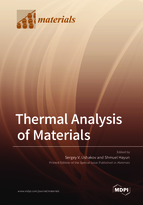Thermal Analysis of Materials
A special issue of Materials (ISSN 1996-1944). This special issue belongs to the section "Advanced Materials Characterization".
Deadline for manuscript submissions: closed (31 December 2020) | Viewed by 61086
Special Issue Editors
Interests: thermal analysis and calorimetry; high temperature diffraction; rare earth oxides
Special Issues, Collections and Topics in MDPI journals
Interests: material science; thermal analysis; advanced ceramics
Special Issues, Collections and Topics in MDPI journals
Special Issue Information
Dear Colleagues,
Thermal analysis of materials encompasses a variety of methods used to detect changes in material properties as a function of temperature. Before temperature measurement became routine in all stages of metal and ceramic processing, early metallurgists relied on color and brightness of hot metal and glassmakers used a viscosity as guidance. Nowadays, techniques of differential thermal analysis (DTA) and differential scanning calorimetry (DSC) routinely yield heat capacities, temperatures and enthalpies of phase transformations in the temperature range from −150 to 1500 °C.
This Special Issue will provide readers with up-to-date information on the recent progress in the thermal analysis field on alloys, ceramics, and polymers from different perspectives spanning materials sciences, thermodynamics, catalysis, and geochemistry.
Contributing papers are solicited in the following areas:
- Differential thermal analysis and scanning calorimetry
- Dilatometry, thermomechanical analysis, and rheology
- High-temperature X-ray and neutron diffraction
- Thermogravimetric and evolved gas analysis
- Thermal diffusivity and thermal conductivity
- Thermo-optical analysis
Measurement of any physical property as a function of temperature brings the method in the realm of thermal analysis. We particularly encourage contributions on combinations of thermal analysis techniques and their applications for measurements of thermodynamic and kinetic properties and phase diagram determinations.
Dr. Sergey V. Ushakov
Prof. Shmuel Hayun
Guest Editors
Manuscript Submission Information
Manuscripts should be submitted online at www.mdpi.com by registering and logging in to this website. Once you are registered, click here to go to the submission form. Manuscripts can be submitted until the deadline. All submissions that pass pre-check are peer-reviewed. Accepted papers will be published continuously in the journal (as soon as accepted) and will be listed together on the special issue website. Research articles, review articles as well as short communications are invited. For planned papers, a title and short abstract (about 100 words) can be sent to the Editorial Office for announcement on this website.
Submitted manuscripts should not have been published previously, nor be under consideration for publication elsewhere (except conference proceedings papers). All manuscripts are thoroughly refereed through a single-blind peer-review process. A guide for authors and other relevant information for submission of manuscripts is available on the Instructions for Authors page. Materials is an international peer-reviewed open access semimonthly journal published by MDPI.
Please visit the Instructions for Authors page before submitting a manuscript. The Article Processing Charge (APC) for publication in this open access journal is 2600 CHF (Swiss Francs). Submitted papers should be well formatted and use good English. Authors may use MDPI's English editing service prior to publication or during author revisions.
Keywords
- Thermal analysis
- Scanning calorimetry
- Thermal diffusivity
- Thermal conductivity
- Thermo-optical analysis
- Thermogravimetry
- Evolved gas analysis








